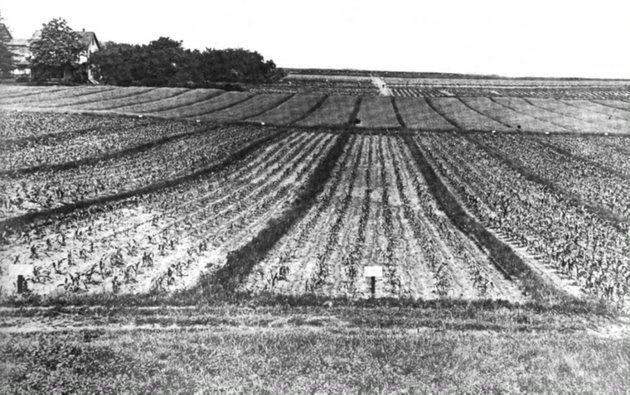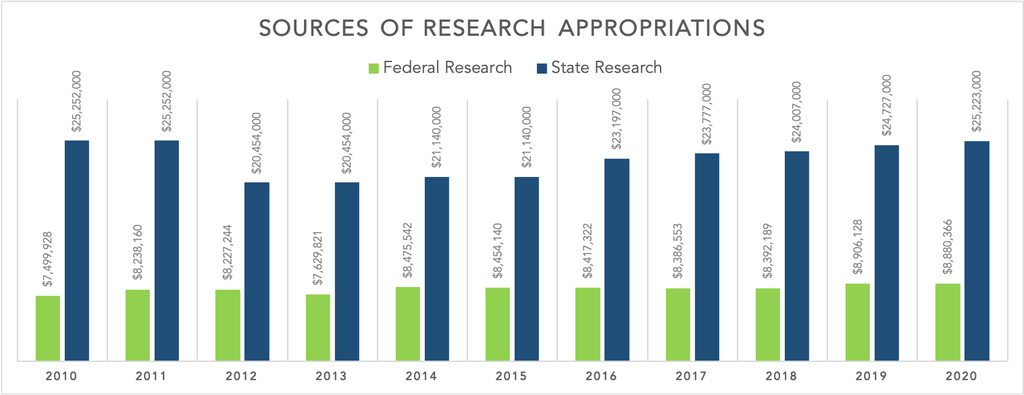Learn more about the history and significance of the Pennsylvania Agricultural Experiment Station.
The Beginnings of the Agricultural Experiment Station
With the passage of the Morrill Land Grant Act in 1862, the federal government committed public land to each state for its use in securing funds to establish "colleges for the benefit of agriculture and the Mechanic arts." These colleges have become known as the nation's land-grant institutions, and The Pennsylvania State University, originally founded as the Farmers' High School in 1855, was designated by the state legislature as the land-grant institution for the Commonwealth.

Agriculture students and faculty in front of the original Old Main building, ca. 1860. Photo from University Park Campus History Collection, Pennsylvania State University Archives.
Over the next twenty-five years, agriculture faculty at the land-grant institutions became a critical source of knowledge and information for farmers in their states. With increasing need for localized experiments to address farmers' immediate problems, college agricultural scientists began to develop test plots on university land. At Penn State, agricultural experimentation began in the early years of the Farmers' High School. By 1867, agriculture faculty and students had access to an experimental farm with more than 200 acres of orchards, pastures, vineyards, and gardens used for studying crop and animal production.

Jordan Fertility Plots, showing the eighth-acre plots divided by permanent two-foot-wide grass strips. Photo from Bezilla, The College of Agriculture at Penn State, 43.
In 1881, Whitman H. Jordan, a faculty chemist, established the Jordan Fertility Plots to examine crop and fertilizer combinations and provide soil testing analyses. From these experiments, Jordan issued free bulletins to Pennsylvania farmers providing tested results of new and innovative approaches that could help them increase their profits. The fertility plots, located near present-day Ag Hill, were arranged into 144 one-eighth-acre plots and became famous as the oldest continuous fertility test plots in the United States. Each plot was planted in a standard Pennsylvania rotation of corn, oats, wheat, and mixed clover and timothy grass and received an application of fertilizers, which was noted on the small sign at the head of the planting. This view is looking north from the future site of Pollock Halls.
Following a number of proposed and failed bills to provide federal support for agricultural experimentation at land-grant institutions, the Hatch Act of 1887 was at last signed into law. The act specifically cited the Morrill Land Grant Act and established the experiment station network under the authority of the land-grant colleges. Significantly, the act also allowed each state to determine the structure of its experiment station and identify the specific research programs according to local or state needs and priorities.
The Pennsylvania Agricultural Experiment Station (AES) opened on June 30, 1887, and continued to offer soil tests and fertilizer analyses from the fertility plots. The AES provided Pennsylvanians with a reliable resource for identifying plants, insects, and fungi, and distributed reports on various agricultural products. Under the leadership of the first experiment station director, Dr. Henry P. Armsby, the Pennsylvania AES received the first appropriations in 1888, the same year the college began construction of a new experiment station building. The new building with fourteen rooms for office and laboratory use was officially dedicated in April 1889. Originally, Armsby focused the efforts of the college's early agricultural experiment station on the subjects of fertilizers and animal nutrition, both of which went hand in hand to provide affordable nutritious feed for livestock. Over the next few years, other priorities emerged with interests among farmers in growing tobacco and fruit orchards.

Agricultural Experiment Station building around the time of its completion. Photo from University Park Campus History Collection, Pennsylvania State University Archives.
The Agricultural Experiment Station Today
Although the original agricultural experiment station building still stands as the Arts Cottage, the Pennsylvania AES does not have a brick-and-mortar presence today. Rather, the Commonwealth's agricultural experiment station is actually the collection of more than 250 College of Agricultural Sciences faculty with research appointments who are conducting USDA-approved agricultural experiments or projects. The faculty are all under one college, but they work across more than 300 buildings on the University Park campus and at the three Research and Extension Centers across the state.
The federal appropriations afforded by the Hatch Act are administered by the USDA National Institute for Food and Agriculture (NIFA) each fiscal year. The funds are allocated according to a formula that establishes the amount each state's experiment station will receive. Hatch funds are one of a number of different appropriations, now referred to as "capacity grants," from USDA NIFA.
For Pennsylvania, the majority of federal funds are distributed to the College of Agricultural Sciences. The stipulations of some of these funds require that states provide at least a one-to-one match. The Commonwealth of Pennsylvania has exceeded this requirement by more than 2.5 times since 2010.

Why Is the Agricultural Experiment Station Important?
At its foundation, the experiment station serves its mandate to use the appropriations
to conduct original and other researches, investigations, and experiments bearing directly on and contributing to the establishment and maintenance of a permanent and effective agricultural industry of the United States, including researches basic to the problems of agriculture in its broadest aspects, and such investigations as have for their purpose the development and improvement of the rural home and rural life and the maximum contribution by agriculture to the welfare of the consumer, as may be deemed advisable, having due regard to the varying conditions and needs of the respective States. (Hatch Act 1887, Sec. 2)
The college applies these appropriations to support faculty salaries and thus sustain our capacity of faculty and program support. These capacity funds ensure that we have the expertise and facilities on hand without having to rely solely on competitive grant cycles to respond quickly and purposefully to emerging challenges, such as climate change and food security, as well as immediate threats, such as a global pandemic or devastating invasive species.
As the stewards of these funds and honoring this responsibility, the College of Agricultural Sciences reports to the USDA through a variety of annual reports. The content of well-written reports can help federal and state scientists and administrators respond to congressional inquiries and shape future policy and funding decisions. Additionally, these reports provide justifications for the continued allocation of the funds and our plans and priorities for the coming years as challenges that face agriculture in the state and nation evolve.
References
Michael Bezilla, Penn State: An Illustrated History (University Park: The Pennsylvania State University Press, 1985). Online.
Norwood Allen Kerr, The Legacy: A Centennial History of the State Agricultural Experiment Stations, 1887–1987 (Columbia: Missouri Agricultural Experiment Station, University of Missouri–Columbia, 1987). Online.
Pennsylvania State University, Agricultural Experiment Station records, 1887–2008, Collection Number 43, Special Collections Library, Pennsylvania State University.

